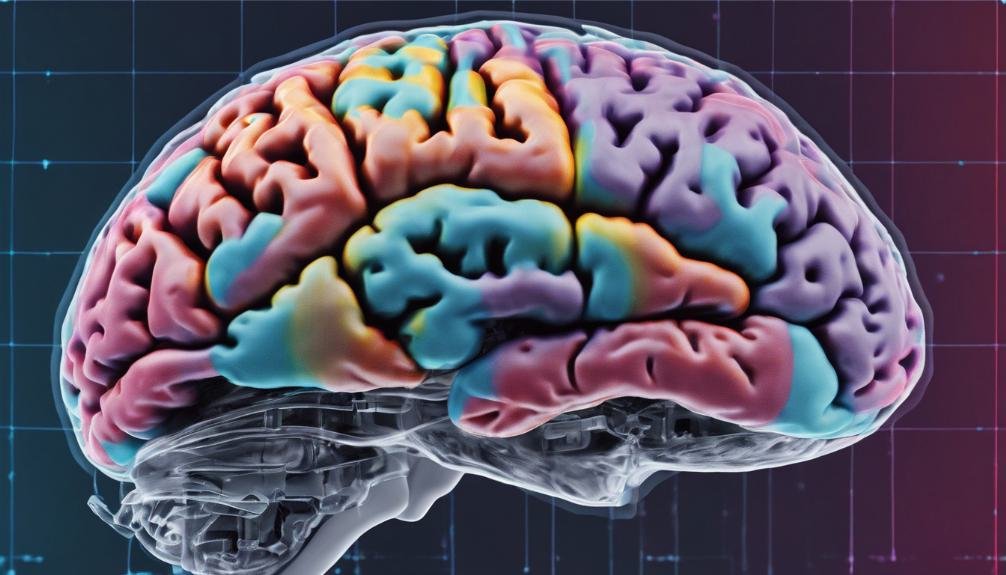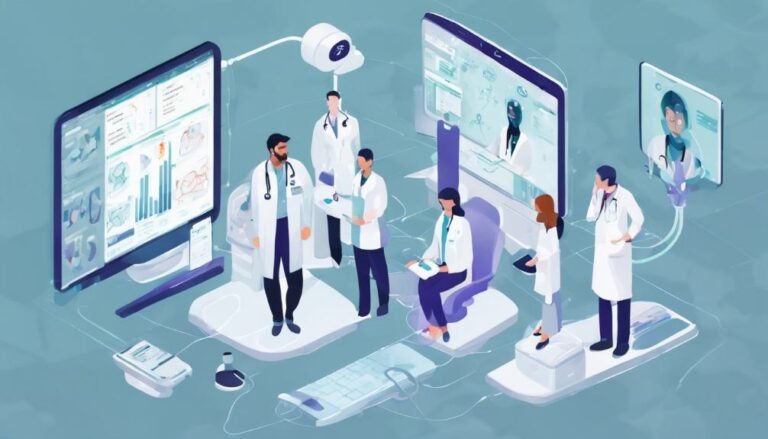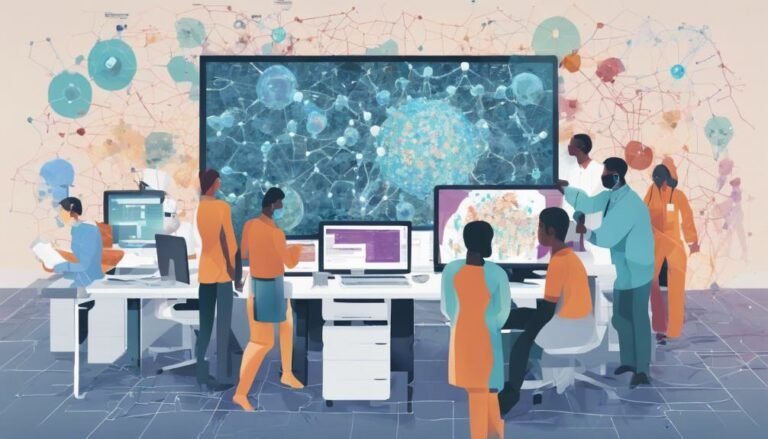AI for PET Scan Analysis
Incorporating AI into PET scan analysis presents a transformative approach that redefines the landscape of diagnostic imaging. Imagine a domain where intricate patterns within scans can be decoded swiftly, anomalies pinpointed with precision, and diagnoses made with heightened accuracy. The potential implications of AI in PET scan analysis extend beyond mere efficiency; they hold the key to accessing new frontiers in disease detection and treatment planning. As we explore the depths of this technological alliance, the horizon of possibilities appears boundless, promising advancements that could reshape the future of healthcare practices.
Key Takeaways
- AI enhances PET scan analysis accuracy and efficiency.
- Machine learning algorithms aid in precise disease detection.
- AI technology optimizes workflow for timely treatment planning.
- Early disease detection facilitated by AI-driven PET scan analysis.
- Future trends focus on ethical AI development for PET scans.
Evolution of PET Scan Analysis
The evolution of PET scan analysis has been marked by significant advancements in imaging technology and computational algorithms. From a historical perspective, PET scans have evolved from being primarily qualitative assessments to quantitative analytical tools. Technological advancements have played a pivotal role in enhancing the spatial resolution, sensitivity, and specificity of PET imaging, enabling more precise detection and characterization of abnormalities within the body.
These improvements have had profound clinical implications, allowing medical professionals to not only visualize metabolic processes but also quantitatively analyze the data obtained from PET scans. Data analysis techniques have evolved to include sophisticated algorithms that can extract valuable information from PET images, aiding in the diagnosis, treatment planning, and monitoring of various diseases such as cancer, neurological disorders, and cardiovascular conditions.
Benefits of AI Integration
Advancements in AI integration have revolutionized PET scan analysis, enhancing the efficiency and accuracy of data interpretation in clinical settings. The synergy between AI advancements and healthcare benefits is evident in the improved speed at which PET scan results are analyzed. Through technology integration, medical advancements have been made possible, allowing for quicker identification of abnormalities or diseases in patients.
AI algorithms can sift through vast amounts of data from PET scans, identifying patterns and anomalies that might be overlooked by human eyes. This leads to more precise and reliable diagnoses, ultimately benefiting patient care.
Moreover, the implementation of AI in PET scan analysis reduces the margin of error, providing healthcare professionals with more confidence in their treatment decisions. By automating certain aspects of data interpretation, AI allows medical practitioners to focus on developing tailored treatment plans based on accurate analysis results.
The seamless integration of AI technology into PET scan analysis not only streamlines the process but also contributes to the overall improvement of patient outcomes.
Enhanced Diagnostic Accuracy
You can expect improved image interpretation with AI integration in PET scan analysis, leading to more precise disease detection.
AI algorithms can enhance the accuracy of identifying subtle abnormalities that might be missed by the human eye.
This increased diagnostic precision has the potential to revolutionize early disease detection and treatment planning.
Improved Image Interpretation
Utilizing artificial intelligence algorithms enhances the diagnostic accuracy of PET scan image interpretation by providing detailed analysis of subtle abnormalities. Machine learning and deep learning models can efficiently process vast amounts of imaging data, allowing for the identification of intricate patterns that might be challenging for human interpretation. These algorithms excel at detecting subtle changes in metabolic activity, tumor characteristics, and organ functionality that are essential for accurate diagnosis and treatment planning.
AI-powered image interpretation in PET scans offers a higher level of precision by minimizing human errors and subjective variability. These algorithms can analyze images in a fraction of the time it would take a human expert, leading to quicker diagnoses and interventions.
Additionally, the ability of AI to learn and adapt from new data continually enhances its diagnostic capabilities, ensuring that it stays up-to-date with the latest advancements in medical imaging technology. By leveraging the power of artificial intelligence, healthcare providers can improve the accuracy and efficiency of PET scan analysis, ultimately benefiting patient outcomes.
Precise Disease Detection
Enhancing diagnostic accuracy in PET scan analysis involves leveraging artificial intelligence algorithms to precisely detect diseases through detailed image interpretation and pattern recognition. Advanced algorithms play a key role in disease classification, enabling AI precision in identifying subtle abnormalities that may be challenging for the human eye to discern.
By utilizing these sophisticated algorithms, AI technology can analyze PET scan images with exceptional accuracy, leading to improved detection rates and more reliable diagnoses.
AI precision in disease detection is achieved through the intricate process of image recognition. The algorithms are trained to recognize specific patterns and anomalies indicative of various conditions, allowing for precise identification and classification of diseases.
This advanced level of image analysis enhances the overall diagnostic accuracy of PET scans, providing healthcare professionals with valuable insights for effective treatment planning and monitoring of patients.
Streamlining Workflow Efficiency
To optimize workflow efficiency in PET scan analysis, consider implementing strategies that streamline the diagnostic process.
By integrating AI technology, you can enhance accuracy and speed in interpreting PET scan results, ultimately improving patient care.
Focus on maximizing workflow efficiency to guarantee timely and precise diagnosis and treatment decisions.
Workflow Optimization Strategies
Efficiently optimizing workflow in PET scan analysis involves strategically reevaluating task sequences and resource allocation to enhance overall operational efficiency. To achieve this, focus on data management and AI training.
Implementing robust data management systems guarantees that the large volumes of data generated during PET scans are organized, accessible, and secure. Concurrently, providing AI with high-quality training data is essential for accurate analysis and reliable results.
Workflow automation plays a pivotal role in streamlining processes. By automating repetitive tasks such as image processing and data entry, staff can redirect their efforts towards more complex and value-added activities. Additionally, software integration is key to harmonizing different tools and systems used in PET scan analysis. Seamless integration reduces manual errors, enhances data flow, and accelerates the overall analysis process.
Incorporating these strategies fosters a more efficient workflow, increasing productivity and allowing healthcare professionals to focus on delivering excellent patient care.
Enhancing Diagnostic Accuracy
By integrating advanced AI algorithms into the PET scan analysis process, you can greatly enhance diagnostic accuracy while streamlining workflow efficiency. Machine learning algorithms play a pivotal role in revolutionizing PET scan analysis by enabling automated detection and classification of abnormalities with high precision. These algorithms sift through vast amounts of imaging data, identifying patterns that may elude the human eye, thereby enhancing diagnostic advancements.
Through the utilization of machine learning algorithms, PET scan analysis can achieve unprecedented levels of accuracy in detecting subtle changes indicative of various conditions, including cancer, neurological disorders, and cardiac diseases. The algorithms learn from vast datasets, continuously improving their ability to differentiate between normal and abnormal findings, ultimately leading to enhanced diagnostic accuracy.
Moreover, the integration of AI-driven solutions into the PET scan analysis workflow not only expedites the interpretation process but also reduces the likelihood of human error. By automating certain aspects of analysis, healthcare professionals can focus their expertise on interpreting results and formulating treatment plans, consequently optimizing workflow efficiency.
Applications in Treatment Planning
Utilizing AI for PET scan analysis in treatment planning streamlines the process by providing precise and personalized insights into the patient's condition. AI algorithms can analyze PET scans to identify specific characteristics of tumors or affected areas with great accuracy. This allows for treatment customization based on the individual's unique physiology and the exact location and extent of the disease.
By incorporating AI into treatment planning, healthcare providers can optimize therapy regimens to target the cancer more effectively while minimizing damage to healthy tissues.
Furthermore, AI enables real-time monitoring of progress during treatment. By continuously analyzing follow-up PET scans, AI algorithms can track changes in the size and metabolic activity of tumors over time. This capability provides healthcare professionals with valuable information to assess the effectiveness of the current treatment plan and make necessary adjustments promptly.
Ultimately, AI-driven treatment planning empowers healthcare teams to deliver more tailored and responsive care to cancer patients, improving outcomes and quality of life.
Overcoming Interpretation Challenges
To address the complexities of interpreting PET scan results accurately, AI algorithms have been developed to enhance the analysis process. Data challenges have traditionally hindered the precise interpretation of PET scans due to the vast amount of information that needs to be analyzed. However, with recent technology advancements, AI can efficiently process and extract valuable insights from these complex datasets.
By utilizing deep learning algorithms, AI can identify patterns and anomalies in PET images that may not be easily recognizable to the human eye, thereby improving the accuracy of diagnostic interpretations.
The clinical implications of AI in PET scan analysis are significant. AI-powered systems can assist radiologists in detecting subtle changes in metabolic activity, aiding in the early detection of diseases such as cancer. However, integrating AI into clinical practice requires adequate training requirements for healthcare professionals to effectively leverage the technology.
Radiologists and nuclear medicine specialists need to familiarize themselves with AI algorithms to guarantee proper utilization and interpretation of AI-generated insights in PET scan analysis.
Potential for Early Detection
AI algorithms demonstrate a promising potential for early detection of diseases through PET scan analysis. By leveraging machine learning and deep learning techniques, these algorithms can analyze PET scan images with high accuracy and efficiency, aiding in the timely identification of abnormalities indicative of various illnesses. This capability holds significant benefits for patients, as early detection allows for prompt medical intervention and treatment planning, ultimately leading to improved outcomes.
Through the utilization of AI in PET scan analysis, healthcare providers can detect subtle changes in metabolic activity that may signify the presence of diseases such as cancer, Alzheimer's, or cardiovascular conditions at their nascent stages. Early intervention based on these findings can result in more effective treatments, better prognoses, and potentially life-saving measures for patients.
The ability of AI to detect abnormalities earlier than traditional methods not only enhances diagnostic accuracy but also paves the way for personalized medicine approaches tailored to individual patient needs.
Future Trends in AI Development
Upcoming advancements in machine learning methodologies are shaping the future trajectory of artificial intelligence (AI) development for PET scan analysis. In this evolving landscape, addressing ethical implications and regulatory challenges is vital.
As AI algorithms become more sophisticated, ensuring data privacy and security will be essential. Developers must implement robust measures to safeguard sensitive patient information during PET scan analysis processes.
Moreover, the detection and mitigation of biases within AI systems are necessary to maintain the accuracy and fairness of PET scan interpretations. By actively monitoring and eliminating biases, AI models can provide more reliable diagnostic insights, benefiting both patients and healthcare providers.
Looking ahead, the integration of explainable AI techniques will enhance transparency in PET scan analysis, allowing clinicians to better understand how AI reaches its conclusions. This transparency not only aids in trust-building but also facilitates regulatory compliance and accountability in the deployment of AI technologies for medical purposes.
Embracing these future trends will certainly shape the ethical and regulatory framework surrounding AI-driven PET scan analysis.
Impact on Patient Care
Developing AI-driven PET scan analysis capabilities holds great promise for enhancing patient care through more accurate and timely diagnostic insights. By leveraging technology advancements in artificial intelligence, patient outcomes can be greatly improved. AI can assist in detecting abnormalities in PET scans with higher precision, leading to earlier detection of diseases and more tailored treatment plans. This clinical impact translates into improved prognoses and increased survival rates for patients.
Furthermore, the integration of AI in PET scan analysis leads to efficiency improvements in healthcare delivery. Automated analysis of PET scans by AI algorithms reduces the time taken to interpret results, allowing for quicker decision-making by healthcare providers. This streamlined process not only benefits patients by expediting diagnosis and treatment initiation but also optimizes resource utilization in healthcare facilities.
Conclusion
To sum up, AI integration in PET scan analysis serves as a beacon of light in navigating the complexities of medical imaging interpretation.
Like a skilled guide through a dense forest, AI technology illuminates the path to precise diagnoses, streamlined workflows, and improved patient care.
Its continuous evolution and adaptability symbolize a future where early disease detection, accurate treatment planning, and enhanced diagnostic accuracy lead the way towards better healthcare outcomes.







